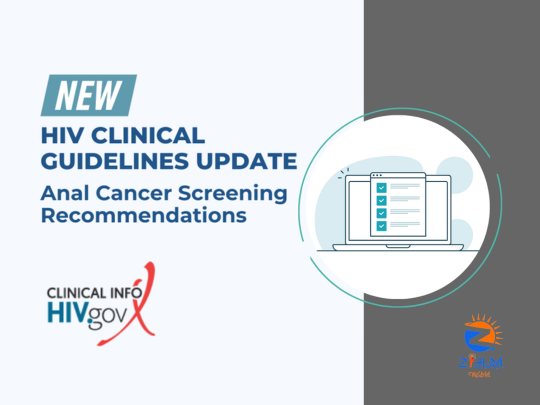
[ad_1]

Cross-posted from: NIH Office of AIDS Research
A panel of experts in HIV care has released new recommendations to prevent anal cancer for people with HIV, the first U.S. federal guidelines on the topic. These recommendations include a screening program that uses high resolution anoscopy (HRA) to help detect and treat precancer and prevent anal cancer for people with HIV.
The guidelines recommend that all adults with HIV be assessed at least once per year for anal abnormalities (such as pain, burning, or masses) and undergo digital anorectal examination (DARE).
People under the age of 35 who are symptomatic or show signs of anal cancer (visual or palpable abnormalities) during DARE should undergo standard anoscopy.
Older people should undergo additional lab-based screening with subsequent HRA, rather than standard anoscopy, if they are among the following populations:
- Men who have sex with men and transgender women ages 35 and older
- All other people with HIV ages 45 and older
This lab-based screening should include collection of anorectal specimens for diagnosis. If there are any abnormalities on those specimens, or symptoms or signs of anal cancer in the initial assessment and DARE, clinicians should make a referral for HRA.
See the complete guidelines on the ClinicalInfo.HIV.gov website.
Alternative course of screening: If HRA is not available, the panel recommends that people with HIV continue to be screened using assessment of symptoms and DARE. People with any symptoms or who show signs of anal cancer should undergo standard anoscopy, without the collection of anal specimens for diagnosis.
Evidence: The panel developed the recommendations based on a careful review of the best available scientific evidence. This evidence included findings from the recent Anal Cancer/HSIL Outcomes Research (ANCHOR) study, funded by the National Cancer Institute at the National Institutes of Health (NIH), which found that the use of HRA helped prevent anal cancer in people with HIV. This evidence supports the use of HRA among certain age groups as specified above. The value of similar screening for younger adults, who are less likely to experience anal cancer, has not yet been established. More research is needed.
Relevance: Anal cancer occurs substantially more often among people with HIV than among people without HIV. Increased age is an important risk factor that has resulted in the age-related recommendations. Human papillomavirus (HPV) is a common sexually transmitted infection. For people with HIV, coinfection with HPV can increase the risk of developing anal cancer. Men with HIV, as well as transgender women with HIV, who have sex with men, are disproportionately affected by anal cancer.
HRA vs. standard anoscopy: HRA, compared to standard anoscopy, enables a more precise examination to detect precancer, guide treatment, and prevent anal cancer. It requires the use of specialized equipment and training for providers. HRA is not yet available everywhere.
Panel: The U.S. Department of Health and Human Services’ (HHS) Panel on the Prevention and Treatment of Opportunistic Infections in Adults and Adolescents with HIV (the panel), which developed the recommendations, is composed of experts in HIV care. The panel is a working group of the NIH Office of AIDS Research Advisory Council (OARAC), in collaboration with the Centers for Disease Control and Prevention, the HIV Medicine Association, and the Infectious Diseases Society of America.
OARAC is a federal advisory committee that provides advice to the Director of the NIH Office of AIDS Research and other federal leaders on HIV research. OARAC responsibilities include coordination of five working groups, or panels, to develop HIV clinical practice guidelines that are disseminated publicly at clinicalinfo.hiv.gov. Panel members monitor the literature and clinical practice continually to determine the need for, and to make, guidelines updates.
HIV.gov note: View our 2022 video conversation with NIH’s Dr. Carl Dieffenbach about the research behind these new recommendations from the NIH-supported ANCHOR Study.
[ad_2]